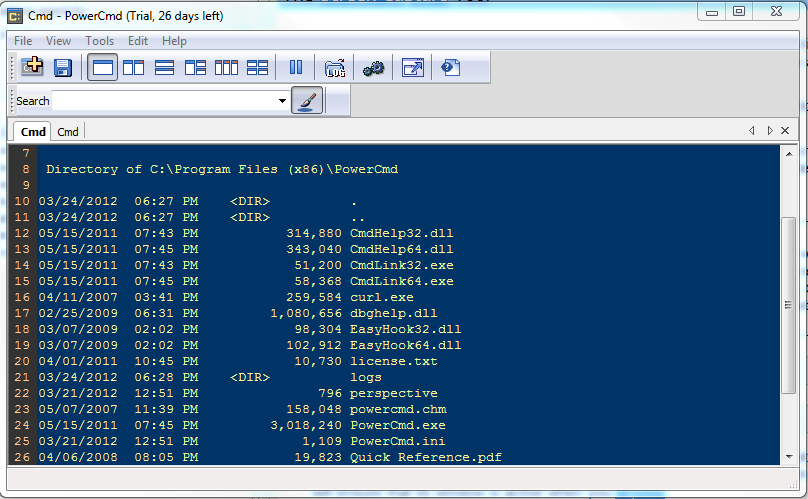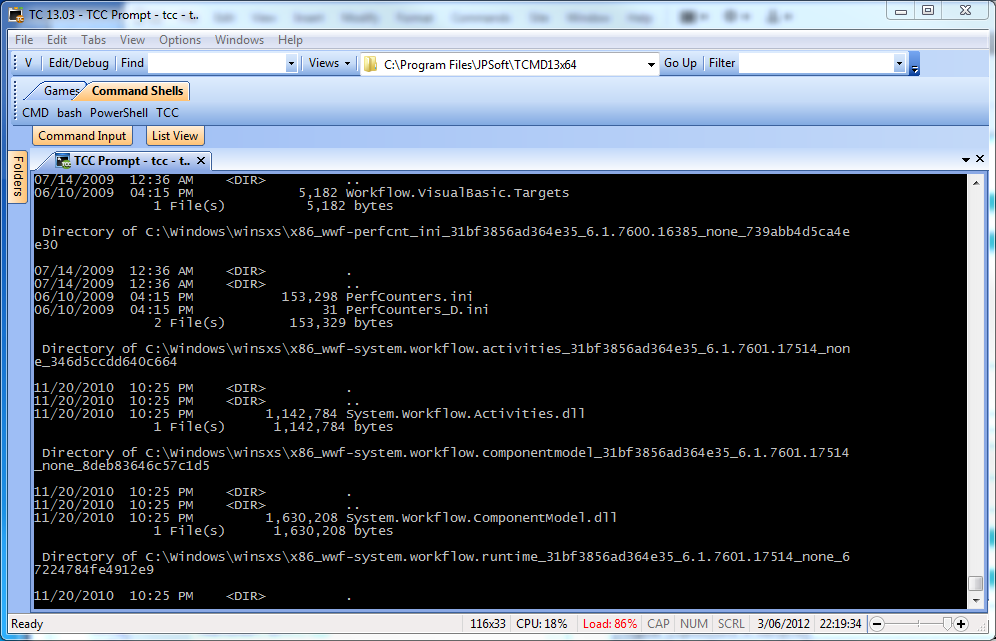Windows Console Replacements, Part 4 - Take Command and PowerCmd
Today we’re looking at PowerCmd, another Windows console replacement. It is available at http://www.powercmd.com. The most recent version is from May 2011.

Note that like Mintty, Console2, and PromptPal, PowerCmd is not a replacement for the Windows CMD command prompt. PowerCmd will start (only) CMD in a new tab window, though you can then load some other command shells (like PowerShell, Bash, etc.). It does not work with TCC or some other command line apps — the TCC output appears, but PowerCmd doesn’t respond to any keyboard input. (Perhaps because TCC reads input a character at a time using a different Windows API than the line-at-a-time API used by CMD?)
PowerCmd adds some features not available in the standard Windows console:
- Tabbed windows
- Horizontal and vertical tab groups
- Configurable fonts and colors
- Line-based or column-based text selection
- Bookmarks
- Line folding (collapsing every n lines into a single line)
- Command history
- Automatically save history logs
- Customizable quick launch toolbar
- Optional transparency
- Popup window for filename completion (current directory only)
- Optional line numbers in the tab windows
- Optional window to display environment variables
- Drag and drop text within PowerCmd
- Resize the window, both horizontally & vertically by dragging the corner
PowerCmd’s display output speed is substantially slower than the stock Windows console, and more than 4 times slower than Take Command. (See the table below.) The line folding and history log options were not enabled for this test; enabling them slows the display output significantly. PowerCmd also didn’t scroll the display smoothly; there were long pauses before it displayed the next page (sometimes several thousand lines further along). The wait cursor would also appear periodically, as well as a “(Not Responding)” message in the PowerCmd title bar.
So how does this compare to Take Command?
- Take Command has more options for displaying the tabbed windows (tab locations, icons, size, themes, etc.)
- Similar functionality in Take Command and PowerCmd
- Similar functionality
- Similar functionality
- Take Command does not have a bookmark option in the tab windows (though bookmarks are supported in the batch debugger)
- Take Command does not have a line folding option (code folding is supported in the batch debugger)
- Command history in Take Command includes many more options
- Similar functionality (Take Command has additional logs, including commands and errors)
- The configurable tabbed toolbar in Take Command includes more options
- Take Command allows you to set different transparencies for active and inactive windows
- The filename completion in Take Command includes many more options, including completing files in other directories and drives, PATH completion, etc.
- Take Command does not have line numbers in tab windows (it does in the batch debugger)
- The Take Command batch debugger has an environment variable window (as well as aliases, functions, batch parameters, and a customizable watch window)
- Take Command also supports drag and drop between the TC windows and other applications; PowerCmd does not.
- Similar functionality (but Take Command also resizes the underlying hidden console window to match the new tab window size)
- Bookmarks
- Line numbering
- Line folding
I’m not aware of any other significant feature in PowerCmd that’s lacking in Take Command. If anybody knows of something in PowerCmd that they would like to see added to Take Command, please let me know.
Let’s take another look at the Take Command window. (The Take Command Explorer-style Folder and List View windows, and the common Command Input window are set to Autohide in order to show a more straightforward comparison with the PowerCmd window.)

And we’ll plug PowerCmd into our comparison table:
|
Features
|
Take Command
|
PowerCmd
|
|
Price (single new copy)
|
$99.95
|
$29.99
|
| Tabbed Windows UI | ||
|
Multiple tabbed windows for console applications
|
|
|
|
Run simple GUI apps in tabs
|
|
|
|
Customize menu accelerator keys
|
|
|
|
Customize tabs location (top/bottom/left/right)
|
|
|
|
Multiple display themes
|
|
|
|
Horizontal / vertical tab groups
|
|
|
|
Attach and detach console windows
|
|
|
|
Optional command input window
|
|
|
|
Cut and paste block and/or line selection
|
|
|
|
Continuously variable transparency option
|
|
|
|
Integrated GUI file explorer
|
|
|
|
User-defined startup tabs
|
|
|
|
Programmable tabbed toolbar
|
|
|
|
Configurable status bar
|
|
|
|
Full text search in tabbed console windows
|
|
|
|
Context-sensitive help for all commands and variables
|
|
|
|
32-bit and 64-bit versions
|
|
|
|
Display Speed
|
Take Command
|
PowerCmd
|
| dir /s c:\windows (in seconds) – Windows console: 38.5 |
19.5
|
94.2
|
|
Command Prompt
|
Take Command
|
PowerCmd
|
|
GUI IDE w/ batch file debugger
|
|
|
|
Aliases (command and directory)
|
|
|
|
Regular Expressions in filenames
|
|
|
|
Wildcards in pathnames and/or filenames
|
|
|
|
Enhanced command line editor
|
|
|
|
Enhanced filename completion
|
|
|
|
GDirectory Navigation
|
|
|
|
ANSI X3.64 text output
|
|
|
|
Built in batch file editor
|
|
|
|
Direct FTP / HTTP file access (including SSL & SSH)
|
|
|
|
Network file system access (OpenAFS)
|
|
|
|
Active Scripting (Perl, Python, VBSscript, Javascript)
|
|
|
|
Scripting Language
|
Take Command
|
PowerCmd
|
| Internal Commands |
182
|
0 *
|
| Internal Variables |
177
|
0 *
|
| Internal Functions |
291
|
0 *
|
*PowerCmd doesn’t include a command interpreter. It always loads CMD when starting tab windows.
I think we’ve exhausted what’s currently available for Windows console replacements (or tabbed windows for console applications). If anybody knows of other alternatives, let me know so I can add them to the comparisons. Barring that, I’ll start with a look at some similar apps on Linux – the Gnome Terminal, KDE Konsole, and iTerm2 for OS X.